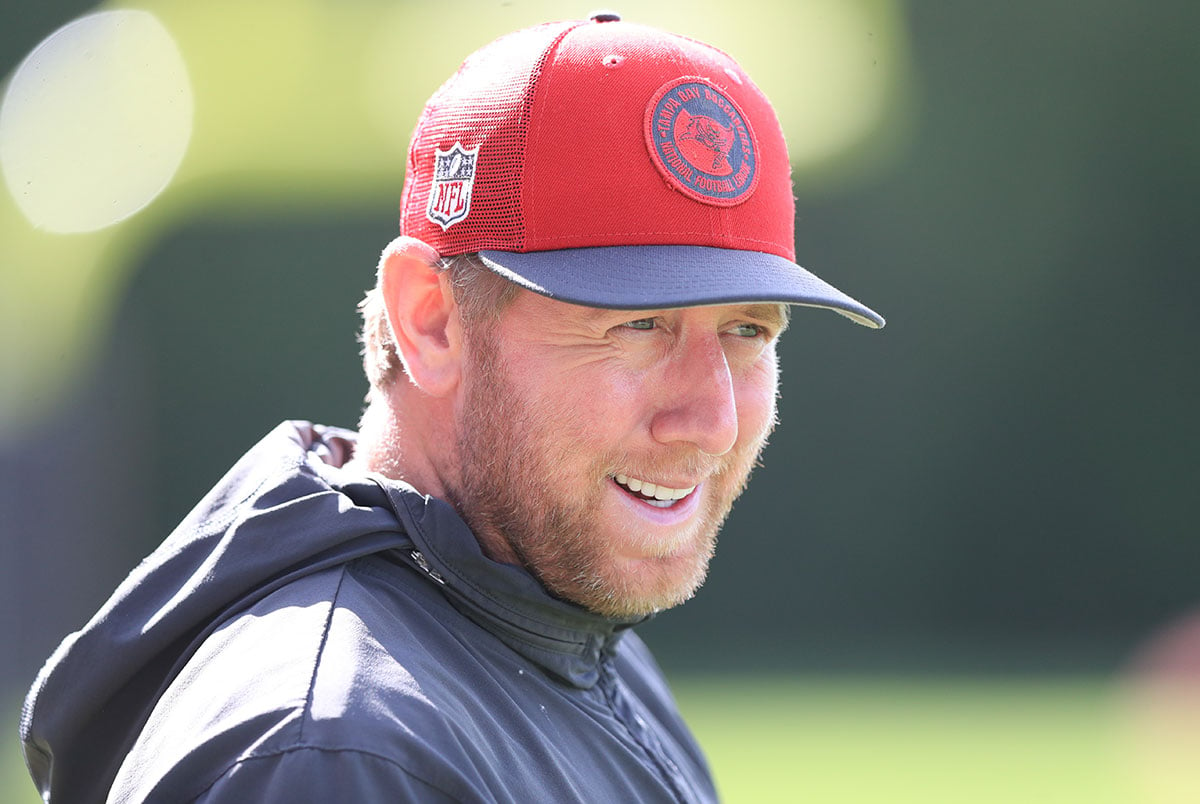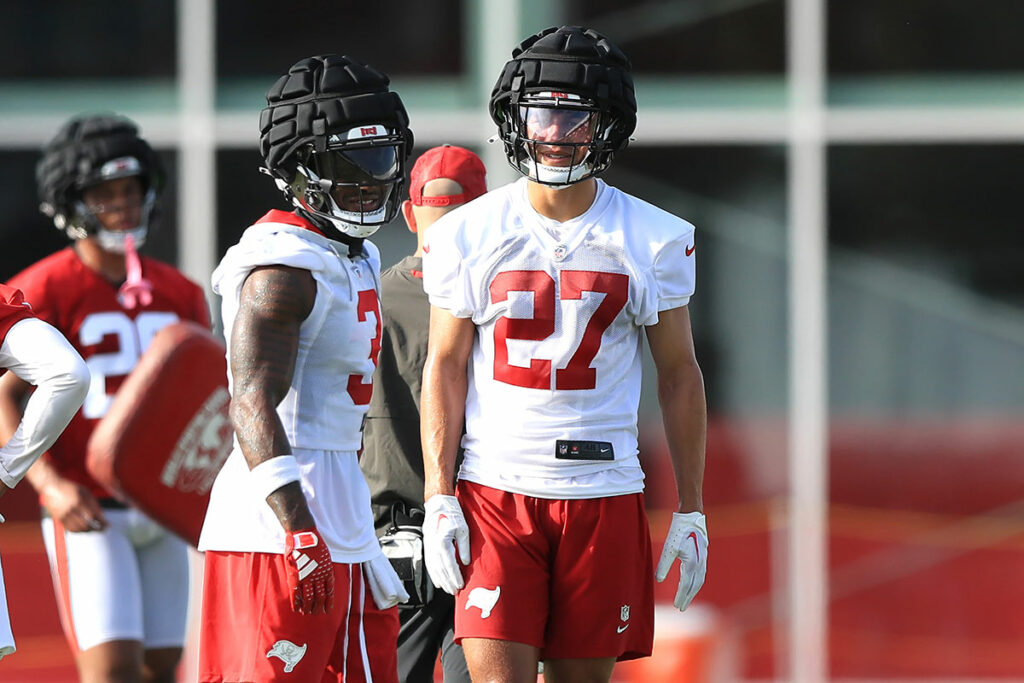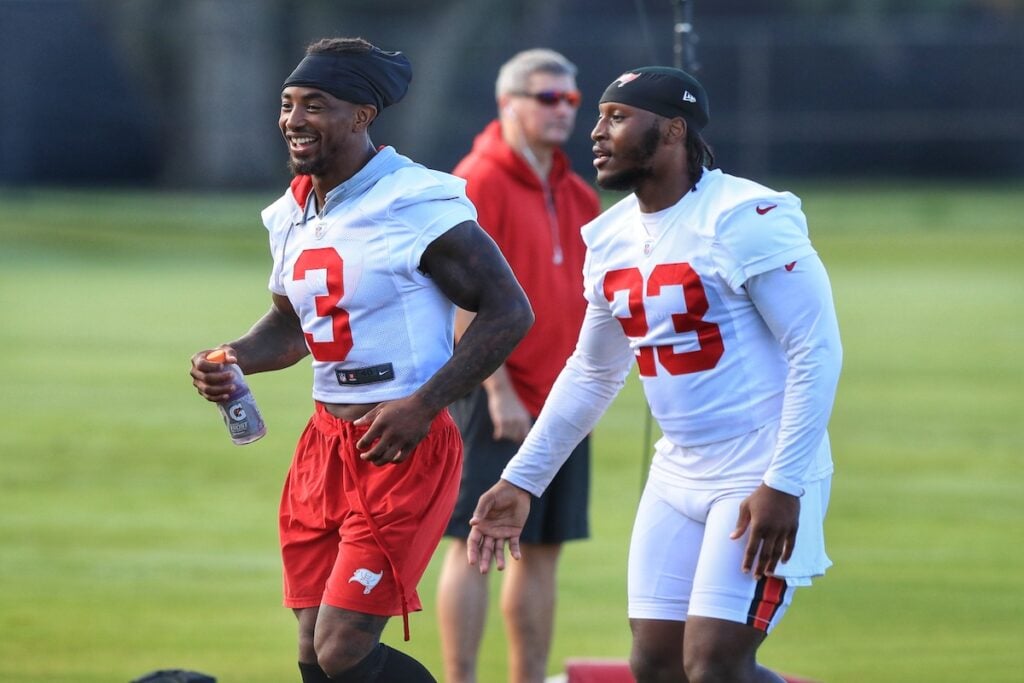INTRO: Bucs training camp is here and there have already been so many noteworthy aspects about Todd Bowles’ team preparing for the 2024 season. Here is my insight and analysis from the start of Bucs camp as the team prepares to don full pads for the first time on Sunday. Enjoy!
FAB 1. Liam Coen’s Offense Is A Huge Upgrade For The Bucs
In just a few short months – and a couple of training camp practices – it’s clear that new offensive coordinator Liam Coen, and the scheme he’s imported from the Los Angeles Rams, is on another level than what the Bucs have been accustomed to. Coen’s offense has been giving Todd Bowles’ defense fits – more often than the head coach would like to see.
And for a team that only scored 21 points per game last year – that’s a good thing.

Bucs HC Todd Bowles and OC Dave Canales – Photo by: Cliff Welch/PR
When Bucs offensive coordinator Dave Canales left Tampa Bay to become the head coach in Carolina, Bowles and general manager Jason Licht didn’t just want Canales’ replacement. They wanted an upgrade.
The Bucs were essentially forced to hire Canales, who had been a quarterbacks coach and receivers coach in Seattle – but never a play-caller – in 2023 because no one wanted the job.
Tom Brady had just retired, and unproven Kyle Trask was the only quarterback on the Bucs roster last February. Bowles had underwhelmed in his first season as head coach with an 8-9 record despite winning the division. And Tampa Bay had been blown out at home in the playoffs by Dallas.
There was little faith around the league that Bowles would still be the Bucs head coach in 2024 and everyone Tampa Bay offered the job to, including Todd Monken who opted for Baltimore and Lamar Jackson instead, turned it down. So Canales, an unproven play-caller, got the job. He was smart and had been around smart coaches, and Canales’ uncanny charisma and believability would serve him well as he learned the ropes of how to call plays at the NFL level – despite never doing before in the pro or college ranks.
The Bucs offense improved as the season went a long last year. After averaging 16.3 points per game in the first seven games, Tampa Bay’s offense averaged 23.6 points per game over the final eight weeks, including the two playoff games. Throw out two season-ending offensive clunkers – a 23-13 loss to New Orleans and a 9-0 win at Carolina – and Tampa Bay’s offense actually averaged 27.8 points per game.
And that was with very little motion, very little shifts and not enough running plays in the playbook. Canales’ play-calling wasn’t quite as predictable as Byron Leftwich’s was, but the limited number of plays and formations didn’t give elite defenses like those in Detroit and San Francisco too many problems.
So what does Coen bring to Tampa Bay from Los Angeles – and also Kentucky, where he called plays in the SEC during the 2021 and 2023 seasons? More motion, more shifts and more running plays designed to keep defenses guessing and eliminate predictability.
And guess what? It’s working.
“It is a lot more movement so the defense cannot just sit there and know what we are doing,” said Bucs wide receiver Mike Evans. “There will be a lot of movement and a lot of eye candy and that is going to help me, and our team a lot.”
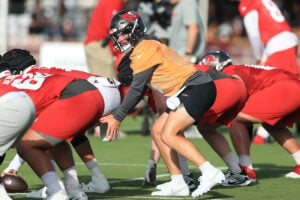
Bucs QB Baker Mayfield – Photo by: Cliff Welch/PR
The Bucs offense won three out of the last-minute series in Thursday’s practice. Here is my write-up from Thursday’s Bucs Camp Insider, detailing the success that Baker Mayfield and Kyle Trask had in Coen’s offense.
Mayfield executed the two-minute drive to perfection. Needing a touchdown for the win, Mayfield took the offense past midfield and found Jalen McMillan for a touchdown on the final play of the drive, beating defensive back Christian Izien, who had a bit of a rough practice.
Trask also drove the Bucs offense down into the red zone, but a last-second pass was deflected by inside linebacker SirVocea Dennis to get a win for the defense. But out of four last-minute tries by the offense, that would be the only drive stymied by Todd Bowles’ unit.
The final series was the Bucs operating near the 10-yard line trailing by eight points with nine seconds left. Mayfield found a wide open Trey Palmer in the corner of the end zone for a touchdown. Zyon McCollum was the nearest defender and it looked like a coverage bust as either McCollum blew the coverage or was expected help that wasn’t there from another Bucs defender. On the game-tying two-point conversion play, Mayfield was pressured from the pocket, eluded outside linebacker Anthony Nelson to his right and then reversed field and scrambled to his left for the conversion, outracing a Bucs defender to the pylon.
Trask ended practice on a high note. In the same scenario, trailing by eight points with nine seconds left, he found Sterling Shepard open in the end zone for the touchdown. Shepard, who beat rookie safety Rashad Wisdom, scored right in front of his family and he ran over and received a kiss on his helmet from his little girl. Then on the two-point conversion, Trask threw a short dart to rookie running back Bucky Irving for the game-tying score to the final play of practice.

Bucs OC Liam Coen – Photo by: Cliff Welch/PR
The expectation is that the Bucs can go from averaging 21.2 points per game in 2023, which ranked 18th in the league, to scoring 24 points per game this season, which is a field goal more, Tampa Bay can level up from a nine-win team into double-digit victories playing opposite a stingy Bowles defense and make the playoffs for a fifth straight year. By comparison, the McVay-led Rams offense averaged 23.7 points per game last year, which ranked ninth in the NFL. The Eagles, whom the Bucs spanked in the playoffs, averaged 24.6 points per game and ranked seventh.
That’s where Coen and Tampa Bay would like to be ranked – inside the Top 10.
And with the likes of Mayfield, who has the full reins to make audibles at the line of scrimmage this year, Evans, Chris Godwin, Rachaad White, Cade Otton, Trey Palmer and newcomers Jalen McMillan and Bucky Irving – both of scored in the waning minutes of Thursday’s practice – that certainly seems doable.
FAB 2. Bucs Had To Modernize Their Offense
All good things must come to an end in life – and in the NFL.
Perhaps no professional sport is more evolutionary than the game of football.
In college football – and especially in the NFL – it’s a yearly practice to adapt or die.

Ex-Bucs coach Lovie Smith – Photo by: Cliff Welch/PR
Long-time Bucs fans remember when Monte Kiffin’s Tampa Bay 2 defense took the league by storm and helped propel turning the franchise from the Yuccaneers to the Buccaneers under Tony Dungy in the late 1990s, and then spearheading the team’s first-ever Super Bowl appearance and victory in 2002.
The Tampa 2 defense was trendy at the time, and in a copycat league, former Bucs defensive assistants like Herman Edwards, Lovie Smith, Mike Tomlin, Rod Marinelli and Raheem Morris all got head coaching jobs as a result. But when Smith, a former Bucs linebackers coach under Dungy and Kiffin, returned to Tampa Bay as head coach in 2014, he was still running a Cover 2 as his base defense.
Offenses around the league had caught on to the Cover 2 scheme by then and developed multiple 2-beater plays and Smith’s defense was shredded as a result. Without the likes of Warren Sapp, Derrick Brooks, John Lynch and Ronde Barber being around anymore, Smith’s defense was old and antiquated, and proved to be his undoing as he was fired after just two years.
When Bruce Arians took over as head coach in 2019, he brought an offense that won a Super Bowl in Pittsburgh and nearly took Arizona to the Super Bowl as well. NFL defenses were catching on to Arians’ scheme, but with the legendary Tom Brady at the helm, along with Mike Evans, Chris Godwin and future Hall of Fame tight end Rob Gronkowski, the Bucs were averaging 25 points per game through the first seven weeks of the 2020 season.
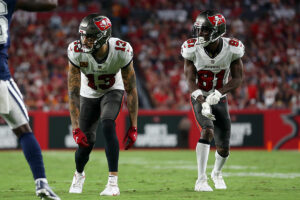
Bucs WRs Mike Evans and Antonio Brown – Photo by: Cliff Welch/PR
That average increased to 30 points per game from Week 8 through Super Bowl LV, which the Bucs won, 31-9, with the addition of wide receiver Antonio Brown. With a star-studded arsenal of weapons, it was just as much talent as it was Arians’ scheme or Byron Leftwich’s play-calling that made Tampa Bay’s offense so potent.
That’s why the Bucs offense struggled mightily when Brown quit on the team near the end of the 2021 season and Gronkowski retired. Tampa Bay no longer had four dangerous weapons in the passing game to confound defenses. It just had two in Evans and Godwin, which made the Bucs offense easier to defend due to double-teams. The Bucs scoring output dropped from 30 points per game in 2021 to just 18 points per game in 2022 as a result.
Dave Canales replaced Leftwich and brought Seattle’s offense to Tampa Bay. But relying on 12 personnel sets (one back, two tight ends, two receivers) 25% of the time when the Bucs didn’t actually have two quality tight ends, played a part in stymying the production on offense. Plus Canales didn’t use much motion or shifts to confuse opposing defenses, which made it easier to shut down Tampa Bay’s offense.
For years, Sean McVay’s offense had given Todd Bowles’ defense fits. The Bucs beat the Rams in Los Angeles in 2019, but only after putting up 55 points and withstanding 40 points from McVay’s attack, which featured Jared Goff completing 45-of-68 passes for 517 yards with two touchdowns and three interceptions that day. Goff and the Rams had gotten the better of the Bucs again in 2020 with a 27-24 win at Tampa Bay.

Rams WR Cooper Kupp and Bucs S Antoine Winfield, Jr. – Photo by: USA Today
And then it was Matthew Stafford and the Rams beating Bowles and the Bucs in a 30-27, heartbreaker in the 2021 NFC Divisional playoffs.
What’s the old adage – if you can’t beat ‘em, join ‘em?
Credit Bowles for leaning into an offensive scheme that has given his defense fits over the years with the hiring of new offensive coordinator Liam Coen. This represents bringing the Bucs offense into the 21st century with the rest of the league as many teams are running a version of the McVay attack.
Combine Coen’s experience as a play-caller, and his imported scheme, which will feature plenty of motions, shifts, three-receiver sets and a more diverse running game, along with the talent on offense that Jason Licht and his staff have assembled, and Tampa Bay’s offense should definitely level up this year.
FAB 3. New Bucs Offense Is Also Helping Tampa Bay’s Defense
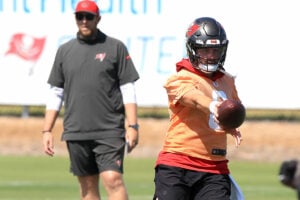
Bucs OC Liam Coen and QB Baker Mayfield – Photo by: Cliff Welch/PR
Part of the problem with the Bucs hiring Dave Canales last year was the fact that he was an unproven play-caller. As a result, head coach Todd Bowles had to prepare him for the season by instituting “call-it” periods during most OTA and training camp practices.
Instead of scripting plays to give the offense and defense certain looks to practice against, it was Canales and Bowles having free rein to call whatever plays they wanted. As a result, each practice was more like a game environment because neither Canales nor Bowles knew what was coming.
While the advantage of that practice helped Canales learn the ropes of play-to-play play-calling, the Bucs defense didn’t get enough of certain looks in training camp to adequately prepare for the season. Without much motion or shifting, Tampa Bay’s offense was more remedial and elementary.
And Tampa Bay’s defense wouldn’t be quite as ready for more advanced offenses on game days as a result.
“They give us a lot of different looks and I feel that’s good for us because they are giving us looks that a lot of teams in the league do,” said Bucs All-Pro safety Antoine Winfield Jr. when asked about the difference on offense with Liam Coen’s scheme this year. “So being able to practice that now in training camp helps us out as much as we’re working out for them. So I feel like that is a good thing for us – to see different looks.”
That’s just another benefit to having Coen and his scheme in Tampa Bay this year. Not only should the Bucs offense be better and less predictable, Bowles’ side of the ball should be more prepared when facing similar offenses like Atlanta’s and San Francisco, and more diverse attacks like the ones in Detroit, Kansas City and Baltimore.
FAB 4. This Bucs Team Feels Like A Super Bowl Contender Already

Bucs HC Todd Bowles – Photo by: Cliff Welch/PR
In my most recent Pewter Pulse video, I’ve gone on record saying that the Bucs’ Super Bowl window is open right now. The team should post double-digit wins if it can stay reasonably healthy, but I think Tampa Bay’s best shot at a Super Bowl comes in 2025. That’s when the Bucs will have more flexibility with the salary cap to make some bold moves, and the team’s young talent will have yet another year of experience and seasoning.
I went into Wednesday’s opening of training camp expecting the first three days of practice, which aren’t in full pads, to be another round of OTAs. Just three more days of essentially flag football.
But that’s not the case.
Despite not having pads on until Sunday, the Bucs’ intensity has ramped up big time in the first two training camp practices. Both sides of the ball are playing faster, more purposeful and more competitively than what we saw in the mandatory mini-camp back in June. I can only imagine how intense Sunday’s practice will be when the Bucs finally don full pads.
I spoke with long-time defensive tackle Will Gholston after Tuesday’s practice. He’s been on bad Bucs teams as well as a member of the Super Bowl LV squad during his time in Tampa Bay. He told me that this year’s defense is faster than the Super Bowl team, and that everybody means business.
The Bucs simply aren’t settling for a fifth straight playoff appearance and a fourth straight NFC South title.
Been there and done that.
This group is taking Bowles’ words to heart. The Bucs are embarking on a Super Bowl season. That’s the mindset and you can see it in practice. It just feels different this year, like a switch has been flipped.
We’ll see if the Bucs can ultimately turn their united goal into a reality come January, but they’re off to the right start for sure.
FAB 5. SR’s Week 1 Standouts In Bucs Camp
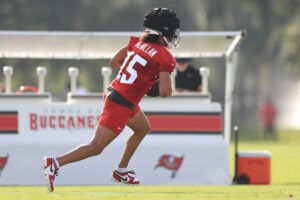
Bucs WR Jalen McMillan – Photo by: Cliff Welch/PR
In the two practices I’ve watched prior to Friday’s SR’s Fab 5 column, there have been a handful of standout players so far. Let’s start on offense.
Quarterback Baker Mayfield and Mike Evans have picked up right where they’ve left off from a year ago. Mayfield has been razor sharp to start camp, and Evans is an ageless wonder at wide receiver. He dominated in camp a year ago, and is starting off that way again.
Rookie wide receiver Jalen McMillan looks like the second coming of Chris Godwin. Smooth, sudden, clutch hands and a precise route-runner. With Trey Palmer struggling with catching a few passes against air in the individual period on Thursday, McMillan’s consistency and knack for making plays has him in the driver’s seat for the No. 3 receiver role.
New receiver Sterling Shepard struggled initially on Wednesday, but had a huge, bounce-back practice on Thursday. I’ve previously said that the 30-year old Shepard might not make the team over younger, faster talent like Rakim Jarrett and Kameron Johnson. But Jarrett has yet to make a big play in camp and might be the most vulnerable. As we previously reported, Johnson has been the camp sleeper at receiver and has made some dazzling catches and touchdowns that have showcased his speed.
Tight end Payne Durham still struggles to separate from coverage and had a few drops on Thursday. With Cade Otton the clear-cut starter, the battle for the No. 2 tight end is wide open. Rookie Devin Culp is making a strong initial impression as a receiver, especially as a red zone threat, getting open and scoring touchdowns.
It’s too early to make impressions about the offensive line given that they don’t have pads on, but Ben Bredeson, who has been starting at left guard next to rookie center Graham Barton, is noticeably bigger than Sua Opeta, who is running with the second string next to center Robert Hainsey. Bredeson is 6-foot-5, 315 pounds, whereas Opeta is 6-foot-4, 305 pounds.
I’ve seen Opeta get rocked back more in pass pro and driven back into the lap of the quarterback, while Bredeson seems to anchor better. Again, we’ll find out more when the pads come on.
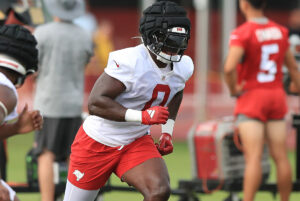
Bucs OLB Yaya Diaby – Photo by: Cliff Welch/PR
On defense, outside linebacker Yaya Diaby has been the star. He’s been unblockable and is playing at a different level. His inside rushes have given right tackle Luke Goedeke fits and he’s racking up would-be sacks. Diaby should be a monster once the pads come on.
Joe Tryon-Shoyinka is the current starter opposite Diaby and no one else has done anything to change that. But it’s still early in camp and there’s a chance that Chris Braswell, Markees Watts or even Jose Ramirez makes a run up the depth chart once the pads come on. Braswell is currently working on the second string opposite Anthony Nelson.
Calijah Kancey’s quickness has taken Barton to school plenty of times already. And Vita Vea is noticeably quicker as well now that he’s slimmed down.
In the secondary, Tykee Smith has shown a knack as a blitzer coming from the slot. He looks polished and hasn’t made the coverage mistakes that Christian Izien has made so far. The coaches rave about Smith’s high football I.Q.
Zyon McCollum looks ready to break out this season. He’s been shadowing Evans in practice and had back-to-back break-ups against No. 13 in the end zone and at the goal line on Thursday’s practice. McCollum’s elite athleticism is on display and his confidence is soaring.
I can’t wait to see this team in pads on Sunday. The competitiveness is already off the charts, which has been a pleasant surprise so far in Bucs training camp.
GET IN THE GAME with BetUS! Receive a 125% BONUS on your first 3 deposits + 10% Gambler’s Insurance when you sign up with BetUS – the Official Sportsbook of Pewter Report. Signing up is FAST and EASY! Visit BetUS.com and sign up using Promo Code: PEWTER
Scott Reynolds is in his 30th year of covering the Tampa Bay Buccaneers as the vice president, publisher and senior Bucs beat writer for PewterReport.com. Author of the popular SR's Fab 5 column on Fridays, Reynolds oversees web development and forges marketing partnerships for PewterReport.com in addition to his editorial duties. A graduate of Kansas State University in 1995, Reynolds spent six years giving back to the community as the defensive coordinator/defensive line coach for his sons' Pop Warner team, the South Pasco Predators. Reynolds can be reached at: [email protected]

